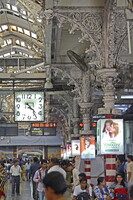| dc.coverage.spatial | Site: Mumbai, Mahārāshtra, India | en_US |
| dc.coverage.temporal | 1878-1888 (creation) | en_US |
| dc.creator | Stevens, Frederick William | en_US |
| dc.date | 1878-1888 | en_US |
| dc.date.accessioned | 2016-06-21T19:10:45Z | |
| dc.date.available | 2016-06-21T19:10:45Z | |
| dc.date.issued | 1878-1888 | en_US |
| dc.identifier | 264725 | en_US |
| dc.identifier.other | archrefid: 3382 | en_US |
| dc.identifier.uri | http://hdl.handle.net/1721.3/180783 | |
| dc.description | Ornamental cast iron columns and brackets in the train shed, outer aisle with shops; The historic railway station is a UNESCO World Heritage Site which still serves as the headquarters of the Central Railways. Designed by Frederick William Stevens with influences from Victorian Italianate Gothic Revival architecture and traditional Mughal buildings, the station was built in the Bori Bunder area of Mumbai to commemorate the Golden Jubilee of Queen Victoria (1887), and named Victoria Terminus. The popularity of the Gothic style was linked with the availability of good local building stone as well as the growth of a workforce well versed in Western techniques of carved masonry. It is the finest Victorian Gothic building in India. Inspired by Scott’s St. Pancras Station in London, it is a monumental affirmation of Victorian civic and imperial pride and an effective measure of the economic stature of the city. Crowned by a huge dome and interwoven with eclectic Indo-Saracenic details, it is an exuberant display of polychromatic stone, decorated tiles, marble and stained glass. The station's name was changed to its present one in March 1996 (named after a 17th century king) and it is now known simply as CST (or CSTM). The CST has 18 platforms; 7 are for locals trains and 11 are for long distance. Source: Grove Art Online; http://www.oxfordartonline.com/ (accessed 7/28/2015) | en_US |
| dc.format.medium | sandstone; limestone; marble; wood | en_US |
| dc.rights | © Scott Gilchrist, Archivision, Inc. | en_US |
| dc.subject | architecture | en_US |
| dc.subject | decorative arts | en_US |
| dc.subject | Great Britain--Colonies | en_US |
| dc.subject | Transportation | en_US |
| dc.subject | Indo-Saracenic | en_US |
| dc.subject | British Raj | en_US |
| dc.subject | Imperialism | en_US |
| dc.subject | Nineteenth century | en_US |
| dc.subject | Anglo-Mughal | en_US |
| dc.title | Chhatrapati Shivaji Terminus | en_US |
| dc.title.alternative | Victoria Terminus | en_US |
| dc.type | image | en_US |
| dc.rights.access | Licensed for educational and research use by the MIT community only | en_US |
| dc.identifier.vendorcode | 1A2-IN-M-CST-A20 | en_US |
| vra.culturalContext | Indian (South Asian) | en_US |
| vra.technique | construction (assembling) | en_US |
| vra.worktype | railroad station | en_US |
| dc.contributor.display | Frederick William Stevens (British (modern) architect, 1847-1900) | en_US |

